|
Last year’s students have gone on to do greater
things, such as Charmaine Reveley, whose collection is reviewed
below, and this year’s trio are set to follow (if not overtake).
Kalya Sowden, who went to Dunedin from
Wellington many years ago, had always sewn. She went to polytechnic
‘out of the blue’ and had started a month later than her fellow
students. Selected by Otago Polytechnic to represent this year’s
emerging talent, it appears she has more than caught up.
Otago had liked her portfolio and she had always
had an appreciation in art. The collection is ‘girly but there are
hard lines,’ according to Sowden, while the forms tend to be ‘random’.
Her upbringing and life experiences helped shape
her style. ‘I do design things that don’t fit the mould. They’re
not mainstream.’
She has always been an individual: ‘My parents
encouraged me to be me. I was able to discover myself from when
I was very young. I’ve always done things my own way.
‘No one can tell me what’s trendy: I have my own
idea.’
Sowden has said that others do understand her
design despite her individual direction. She showed well finished
(not just overlocked, but bound) knickerbockers in black, a pink
singlet with covered buttons and suspender clips, and a white singlet
with a column of buttons down the left. What linked these were the
form that lay somewhere between soft and edgy and Sowden’s use of
natural fabrics, which she believes enable garments to breathe better,
giving the wearer greater comfort.
Like Sowden, Joan Leach, another student,
was self-taught but admitted to lacking confidence—a personality
trait, she believes—when she began her course. She went full-time
in her B.Des. degree after a weekend of soul-searching and figuring
out how best her study would fit in with her raising her three sons,
aged 13 to 20.
It seems it didn’t matter quite as much. Her sons’
comment, she said, was, ‘We’d rather Mum sells the clothes because
of the money we’d get.’ Her husband supported her career decision,
too. However, she still rates her children as her number-one priority.
Leach does not believe in age as a target in marketing
her designs. Instead, she believes in an attitude. Her aim is to
create classic styles with subtle touches.
As with all entrepreneurs, Leach has been ingenious
with many aspects of her business. She had newly set up a shared
studio when Lucire spoke with her and was steadily shifting
her felting from home to work. Her swing tickets and business cards
have been self-designed and look as though a professional had done
them, proof that talent transcends pigeon-holing. (It helps, too,
that Leach loves design in buildings and gardens.) Her ‘ultimate’
model of how she’d like her career to be is Mild Red’s Donna Tulloch.
Her collection was based around natural fibres
and had spent considerable time researching it. It showed. Of the
three student collections, Leach’s was the best—which is not to
say Sowden’s and Katie King’s (detailed below) were lacking. Leach’s
white skirt gave the impression of fallen oversized feathers. A
black belt worn above the bust had the addition of a jewelled strand.
Leach did not go overboard, but kept every item tasteful, preferring
to impress us with harmonious design and a sense that extravagance
was "bubbling under".
Katie King was not present for her own
show due to a commitment in California, but had her sister and Otago
Polytechnic’s Margo Barton sit in for interviews. They proved to
be more than suitable commentators for King’s 1970s-inspired autumn–winter
collection.
The Dogtown and Zboyz skater style was
mixed with ’70s Rolling Stones, although both felt that King’s designs
were of-the-minute. King openly appropriated past references, including
television show MacGyver, its name intentionally misspelt
to avoid legal problems. King’s postmodern humour, shown by the
lettering on the garments, came through with ‘Get high, climb a
tree’. ‘What would McGuyver (sic) do?’ and ‘Tree Climber’
were signs of King’s eccentric nature. Her sister, Philippa, said
that King was always ‘one stop ahead’.
We did enjoy King’s pink bodysuit, its white zips
a nice offset; her glam ’70s-inspired gold top with brown trim;
and her floral prints on the pockets of her brown shorts. The print
was repeated on the two men’s items, including the use of pink on
a tie and suspender belts (which were, again, unsuspended—this is
Dunedin, after all).
One of Dunedin’s most "thinking" designers,
Fieke Neuman, fielded her ‘String Theory’ collection for
her Fieke label. The humble string was used in different ways throughout,
either literally or as a print, on what Neuman called ‘amusing daywear’
featuring macramé, screen-printed wool and canvas, fur and
duffle. Her off-the-shoulder asymmetric white top was elegant although
colour-wise, Neuman opted more for blacks, greys and greens. Her
final model for the catwalk section was pregnant, in her only appearance
at ID.
CONTINUED

Fieke
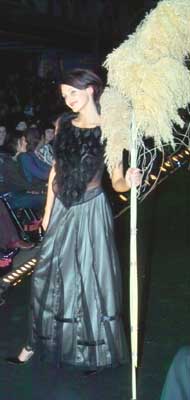 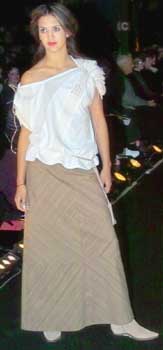 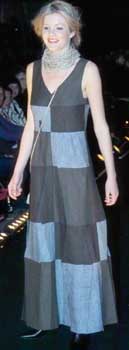 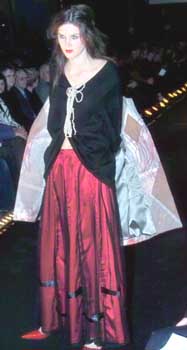
|
Kalya Sowden: ‘No one
can tell me what’s trendy: I have my own idea’
Kalya Sowden
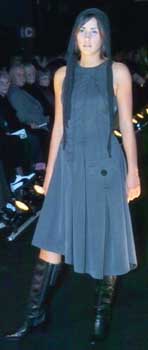
Joan Leach
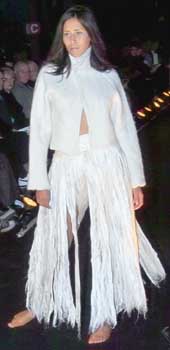 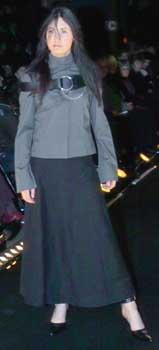
Katie King
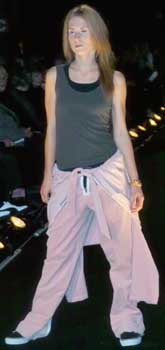 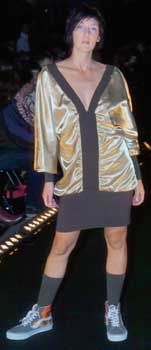
|

